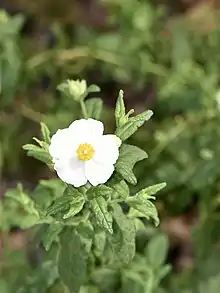Cistus inflatus
Cistus inflatus is a shrubby species of flowering plant in the family Cistaceae, often known as Cistus psilosepalus, although this name is a synonym of the hybrid Cistus × laxus. It has white flowers.
| Cistus inflatus | |
|---|---|
 | |
| Scientific classification | |
| Kingdom: | Plantae |
| Clade: | Tracheophytes |
| Clade: | Angiosperms |
| Clade: | Eudicots |
| Clade: | Rosids |
| Order: | Malvales |
| Family: | Cistaceae |
| Genus: | Cistus |
| Species: | C. inflatus |
| Binomial name | |
| Cistus inflatus | |
| Synonyms | |
Description
Cistus inflatus is a slightly spreading shrub, up to 1 m (3 ft) tall. It leaves are green, oblong in shape, usually 2–6 cm (0.8–2.4 in) long by 5–20 mm (0.2–0.8 in) wide, with turned under (revolute) margins, variably hairy, with long simple and stellate hairs on both sides. The leaves are unstalked (sessile) and, at least near the base, have three veins. The flowers are arranged in cymes with one to five individual flowers, each 4–6 cm (1.6–2.4 in) across with five white petals with narrowed yellow bases, and five sepals. The style is very short.[2][3]
Taxonomy
Cistus inflatus has a somewhat confused nomenclatural history. In 1786, Jean-Baptiste Lamarck described this species under the name Cistus hirsutus, but it was an illegitimate name since he had earlier used it for a different species.[4][5] In 1826, Robert Sweet published the name Cistus psilosepalus,[6] which was then applied to this species by many authors.[5] In 1997, Jean-Pierre Demoly identified Sweet's type as C. × laxus Aiton, a hybrid between this species and C. populifolius.[3][5][7] As the name Cistus laxus was published by Aiton in 1789, it has priority over the name Cistus psilosepalus, which becomes a synonym. Demoly revived a name used (but not published) by Pierre André Pourret, namely C. inflatus.[7]
In summary, in Demoly's analysis:
- Cistus psilosepalus Sweet is a synonym of Cistus × laxus Aiton
- Cistus psilosepalus auct., non Sweet has incorrectly been used for what is now Cistus inflatus Pourr. ex J.-P.Demoly
Sweet called his C. psilosepalus "the smooth sepaled rock-rose" (the meaning of the epithet), describing it as "differing from all others ... by its smooth glossy sepals",[8] whereas later sources (including Flora Europaea) described C. psilosepalus as having hairy sepals.[2] In C. × laxus the backs of the outer sepals are hairless (glabrous); in C. inflatus they are hairy.[3]
A 2011 molecular phylogenetic study placed C. inflatus in the white and whitish pink clade of Cistus species. No particularly close relationship to any other species in the clade was identified.[9]
Phylogeny
Cistus inflatus belongs to the white and whitish pink flowered clade of Cistus species.
| Species-level cladogram of Cistus species. | ||||||||||||||||||||||||||||||||||||||||||||||||||||||||||||||||||||||||||||||||||||||||||||||||||||||||||||||
| ||||||||||||||||||||||||||||||||||||||||||||||||||||||||||||||||||||||||||||||||||||||||||||||||||||||||||||||
| Species-level cladogram of Cistus species, based on plastid and nuclear DNA sequences.[10][11][12][9] |
Distribution
Cistus inflatus (generally recorded as C. psilosepalus) is native to Portugal, western Spain, and two small regions of north-west France.[2][13]
References
- "Cistus inflatus", The Plant List, retrieved 2015-03-02
- Warburg, E.F. (1968), "Cistus psilosepalus", in Tutin, T.G.; Heywood, V.H.; Burges, N.A.; Valentine, D.H.; Walters, S.M. & Webb, D.A. (eds.), Flora Europaea, Volume 2: Rosaceae to Umbelliferae, Cambridge University Press, p. 283, ISBN 978-0-521-06662-4
- "Cistaceae Cistus inflatus Pourr.", Living Collection Virtual Herbarium, Sven Landrein, archived from the original on 2015-04-02, retrieved 2015-03-14
- "Cistaceae Cistus hirsutus Lam.", The International Plant Names Index, retrieved 2015-03-14
- "Cistus psilosepalus auct". Germplasm Resources Information Network. Agricultural Research Service, United States Department of Agriculture. Retrieved 2015-03-14.
- "Cistus psilosepalus", The Plant List, retrieved 2015-03-14
- Demoly, J.-P. (1997), "L'identité du Cistus psilosepalus Sw. (Cistaceae)", Acta Botanica Gallica (in French), 144 (1): 35–44, abstract (in French and English)
- Sweet, Robert (1826), "33 Cistus psilosepalus", Cistineae : the natural order of Cistus or Rock-rose, London: James Ridgeway, retrieved 2015-03-15
- Civeyrel, Laure; Leclercq, Julie; Demoly, Jean-Pierre; Agnan, Yannick; Quèbre, Nicolas; Pélissier, Céline & Otto, Thierry (2011). "Molecular systematics, character evolution, and pollen morphology of Cistus and Halimium (Cistaceae)". Plant Systematics and Evolution. 295 (1–4): 23–54. doi:10.1007/s00606-011-0458-7. S2CID 21995828.
- Guzmán, B. & Vargas, P. (2005). "Systematics, character evolution, and biogeography of Cistus L. (Cistaceae) based on ITS, trnL-trnF, and matK sequences". Molecular Phylogenetics and Evolution. 37 (3): 644–660. doi:10.1016/j.ympev.2005.04.026. PMID 16055353.
- Guzmán, B. & Vargas, P. (2009). "Historical biogeography and character evolution of Cistaceae (Malvales) based on analysis of plastid rbcL and trnL-trnF sequences". Organisms Diversity & Evolution. 9 (2): 83–99. doi:10.1016/j.ode.2009.01.001.
- Guzman, B.; Lledo, M.D. & Vargas, P. (2009). "Adaptive Radiation in Mediterranean Cistus (Cistaceae)". PLOS ONE. 4 (7): e6362. Bibcode:2009PLoSO...4.6362G. doi:10.1371/journal.pone.0006362. PMC 2719431. PMID 19668338.
- "Cistus inflatus Pourr. ex Demoly", eFlore (in French), Association Tela Botanica, retrieved 2015-03-14
External links
- Page, R.G. (n.d.) [2002 onwards], "Cistus inflatus Pourr. ex Demoly", The Cistus & Halimium Website, archived from the original on 2015-09-23, retrieved 2015-03-14; includes photograph